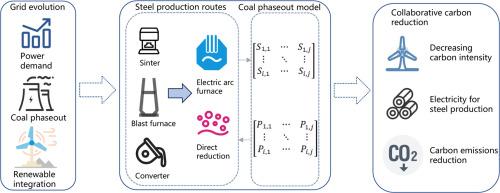From coal to green power: Mapping the electrification journey of China's steel sector
IF 10.9
1区 环境科学与生态学
Q1 ENGINEERING, ENVIRONMENTAL
引用次数: 0
Abstract
As a significant contributor to global carbon emissions, China's iron and steel industry is transitioning toward electrification to meet its 2060 carbon neutrality targets. To explore the relationship between the growing electricity demand for steel production and the decarbonization of the power grid, we developed an integrated framework that combines the evolution of the industry’s electrification with the decarbonization of the nation’s power system. The results indicate that the adoption of more electricity-intensive processes will lead to a substantial increase in electricity demand, rising from 474.16 TWh to 513.19 TWh by 2060. Concurrently, as the share of coal-fired electricity declines from 68.52 % to 4.96 %, carbon emissions from electricity consumption are projected to decrease to only 14.88 % of 2020 levels, avoiding an annual emission of 260.71 million tons (Mt) through grid decarbonization. This study underscores the significant potential for emissions reduction through coordinated cross-sectoral efforts to achieve net-zero emissions.

从煤炭到绿色能源:描绘中国钢铁行业的电气化之旅
作为全球碳排放的重要贡献者,中国的钢铁行业正在向电气化过渡,以实现其2060年的碳中和目标。为了探索钢铁生产不断增长的电力需求与电网脱碳之间的关系,我们开发了一个综合框架,将行业电气化的发展与国家电力系统的脱碳相结合。结果表明,采用更多的电力密集型工艺将导致电力需求大幅增加,到2060年将从474.16太瓦时增加到513.19太瓦时。与此同时,随着燃煤发电的份额从68.52%下降到4.96%,电力消费的碳排放量预计将降至2020年水平的14.88%,通过电网脱碳,每年可避免排放2.6071亿吨(Mt)。这项研究强调了通过协调跨部门努力实现净零排放来减少排放的巨大潜力。
本文章由计算机程序翻译,如有差异,请以英文原文为准。
求助全文
约1分钟内获得全文
求助全文
来源期刊

Resources Conservation and Recycling
环境科学-工程:环境
CiteScore
22.90
自引率
6.10%
发文量
625
审稿时长
23 days
期刊介绍:
The journal Resources, Conservation & Recycling welcomes contributions from research, which consider sustainable management and conservation of resources. The journal prioritizes understanding the transformation processes crucial for transitioning toward more sustainable production and consumption systems. It highlights technological, economic, institutional, and policy aspects related to specific resource management practices such as conservation, recycling, and resource substitution, as well as broader strategies like improving resource productivity and restructuring production and consumption patterns.
Contributions may address regional, national, or international scales and can range from individual resources or technologies to entire sectors or systems. Authors are encouraged to explore scientific and methodological issues alongside practical, environmental, and economic implications. However, manuscripts focusing solely on laboratory experiments without discussing their broader implications will not be considered for publication in the journal.
 求助内容:
求助内容: 应助结果提醒方式:
应助结果提醒方式:


